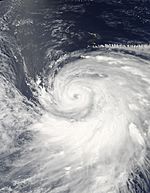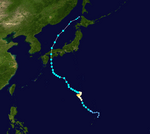Typhoon Krosa (2019) facts for kids
Quick facts for kids Typhoon (JMA) |
|||
|---|---|---|---|
| Category 3 typhoon (SSHS) | |||
|
|||
| Duration | August 5 – August 16 | ||
| Intensity | 155 km/h (100 mph) (10-min), 950 mbar (hPa) | ||
Typhoon Krosa was a powerful storm that hit Japan in August 2019. It was part of the 2019 Pacific typhoon season, which is the time of year when many strong storms form in the Pacific Ocean. Krosa was the storm that came right after another big typhoon named Lekima.
Contents
How the Storm Formed and Moved
Starting as a Tropical Depression
The storm began as a "tropical depression" on August 5. This is like a baby storm, a low-pressure area with some thunderstorms. It formed near the Mariana Islands, which are islands in the Pacific Ocean.
Growing into a Typhoon
By August 6, the storm got stronger and was named Krosa. It became a "tropical storm." Soon after, Krosa grew even more powerful and turned into a "typhoon." A typhoon is a very strong tropical storm, similar to a hurricane.
On August 8, Typhoon Krosa became very strong, reaching what we call a Category 3-equivalent typhoon. This means its winds were very fast and dangerous.
Weakening and Moving Towards Japan
After reaching its strongest point, Krosa started to get weaker. This happened because it moved over cooler ocean water. Cooler water doesn't give storms as much energy.
By August 13, Krosa was no longer a typhoon; it had weakened back into a tropical storm. It kept moving slowly towards Japan. Even though conditions were a bit helpful, Krosa didn't get stronger again before it reached Japan.
On August 14, Krosa moved into the Sea of Japan. A few days later, on August 16, it changed into an "extratropical low." This means it became a different kind of weather system, losing its tropical storm features.
What Krosa Did in Japan
Heavy Rain and Strong Winds
Typhoon Krosa brought a lot of rain to parts of Japan, especially to areas like Shikoku and Honshu. One place, Yanase in Kōchi Prefecture, got a huge amount of rain – about 869.5 millimeters (34.23 inches). That's like a lot of buckets of water!
The winds were also very strong. In Muroto, wind gusts reached up to 151 kilometers per hour (94 miles per hour). These strong winds can cause a lot of damage.
Impact on People and Farms
Sadly, the storm caused some problems. The rough waves from the storm were very dangerous, and some people were affected by them. Flooding also caused issues for others. In total, 55 people were hurt in different incidents because of the storm.
The storm also damaged farms in Japan. The cost of damage to crops and farms was about ¥279.61 million. This is a lot of money, about US$2.64 million, showing how much the storm affected farming communities.
Images for kids





